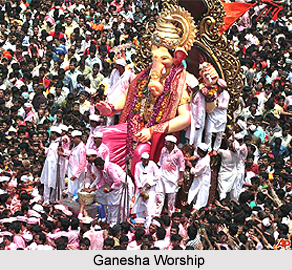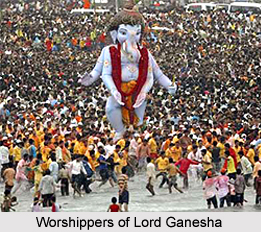 Ganapatyas or the Ganapatya Sect refers to a group of religious worshippers of Hinduism who worship Lord Ganesha as the Saguna Brahman. The Ganapatyas are a distinctive faith and consider the elephant-faced deity as the Supreme Lord. Ganesha or Ganapati is regarded as the Brahmanaspati in the Vedas and rules the base of energy centres. Hindus believe that Lord Ganesha should be invoked before beginning of prayers and commencement of various religious ceremonies and other important tasks and projects. The adoration of Vinayaka or Ganesha is believed to be complementary with the worship of other gods. In Hinduism, the worship is the five main gods or Panchayatana Puja is considered of utmost importance. The ritual includes the invocation of Lord Shiva, Lord Vishnu, Lord Surya, Goddess Shakti (Devi) and Lord Ganesha.
Ganapatyas or the Ganapatya Sect refers to a group of religious worshippers of Hinduism who worship Lord Ganesha as the Saguna Brahman. The Ganapatyas are a distinctive faith and consider the elephant-faced deity as the Supreme Lord. Ganesha or Ganapati is regarded as the Brahmanaspati in the Vedas and rules the base of energy centres. Hindus believe that Lord Ganesha should be invoked before beginning of prayers and commencement of various religious ceremonies and other important tasks and projects. The adoration of Vinayaka or Ganesha is believed to be complementary with the worship of other gods. In Hinduism, the worship is the five main gods or Panchayatana Puja is considered of utmost importance. The ritual includes the invocation of Lord Shiva, Lord Vishnu, Lord Surya, Goddess Shakti (Devi) and Lord Ganesha.
Ganapatya Sect is among the five main sects in Hinduism, along with Vaishnavism, Shaivism, Shaktism and Smartism (Smarta Sampradaya). The Advaita philosophy is followed by the Ganapatyas.
History of Ganapatyas
 Since the 5th century, Lord Ganesha was venerated as part of Shaivism. The Ganapatya Sect was developed between 6th century and 9th century. Around the 10th century, the Ganapatyas attained a high point. The worshippers of Lord Ganesha established several renowned temples devoted to the Lord, such as, the Ucchi Pillayar temple on Rock Fort of Tiruchirapalli (Trichy) in the state of Tamil Nadu. The temple consists of thousand pillars and is one of the largest Ganesha temples. During the later period, the Ganapatya Sect was promoted and propagated by Sri Morya Gosavi.
Since the 5th century, Lord Ganesha was venerated as part of Shaivism. The Ganapatya Sect was developed between 6th century and 9th century. Around the 10th century, the Ganapatyas attained a high point. The worshippers of Lord Ganesha established several renowned temples devoted to the Lord, such as, the Ucchi Pillayar temple on Rock Fort of Tiruchirapalli (Trichy) in the state of Tamil Nadu. The temple consists of thousand pillars and is one of the largest Ganesha temples. During the later period, the Ganapatya Sect was promoted and propagated by Sri Morya Gosavi.
Afterwards, the Ganapatyas developed as one of the prominent sects in Hinduism and gained much popularity in Maharashtra state between the 17th century and the 19th century.
The worshippers of Lord Ganesha worshipped the deity as the absolute and ultimate God. This resulted in the formation of a new religious cult known as the Ganapatya Sect. The basic principles of the sect are based on the Ganapati Upanishad or Ganapati Atharvashirsa. The Vedic religious scripture worships Ganesha as the incarnation of the ultimate Brahman. He is glorified as the creator, the preserver and the destroyer. Ganesha contains all other heavenly forms within himself. The Lord is the creator of the universe and also sustains the universe and destroys it. The Ganapatyas consider as the all pervading reality and a personification of the eternal self or the Atman. Moreover, the work mentions that the lord is identified with Aum (Om) and all the other Gods and deities in Hindu religion, such as Lord Shiva, Lord Vishnu, Lord Brahma, Lord Chandra, Lord Indra, Lord Agni, Lord Surya, Lord Vayu and others. It is also believed that the 3 Lokas or worlds, namely Swargaloka, Antarikshaloka and Bhuloka are within the Lord.
The Ganapatyas also associated Lord Ganapati with Shakti. Although Ganesha was originally considered as a Brahmachari or bachelor, but with the development of Shaktism, the deity was related with 2 goddesses, namely Buddhi and Siddhi or Lakshmi and Saraswati. This form of the deity was referred as the Shakti Ganapati form. The Ganapatyas worshipped five forms of the Lord, namely Lakshmi Ganapati, Pingala Ganapati (Siddhi Ganapati), Urdhva Ganapati, Maha Ganapati and Ucchishta Ganapati. Eventually sub-sects were formed the adored each of these incarnations of the Lord. Apart from these, the Ganapatya Sect recognized three other forms of Lord Ganesha, Santa Ganapati, Svarna Ganapati and Navanita Ganapati. However, all the sub-sects considered Lord Ganesha as the Supreme Lord and creator, preserver and destroyer of the universe.
The members of the Ganapatya Sect introduced two new Upapuranas that were exclusively devoted to the deity. These religious scriptures were known as Mudgala Purana and Ganesha Purana. They also composed the Ganesha Gita, which was a version of the Bhagavad Gita with Lord Ganesha in the divine role. These scriptures reflected the main beliefs, philosophies, principles, practices, methods of worship and hymns or mantras of the Ganapatya sect.
Some high caste Hindus in Maharashtra still follows the principles of the religious sect. Moreover, the Ganapatya Sect is still significant in South India. The worshippers of Lord Ganesha conduct an annual pilgrimage between Pimpri-Chinchwad and Moragaon. The marks of the Ganapatyas include the marks of an elephant face and tusk on the shoulders and a red circle on the forehead.




















